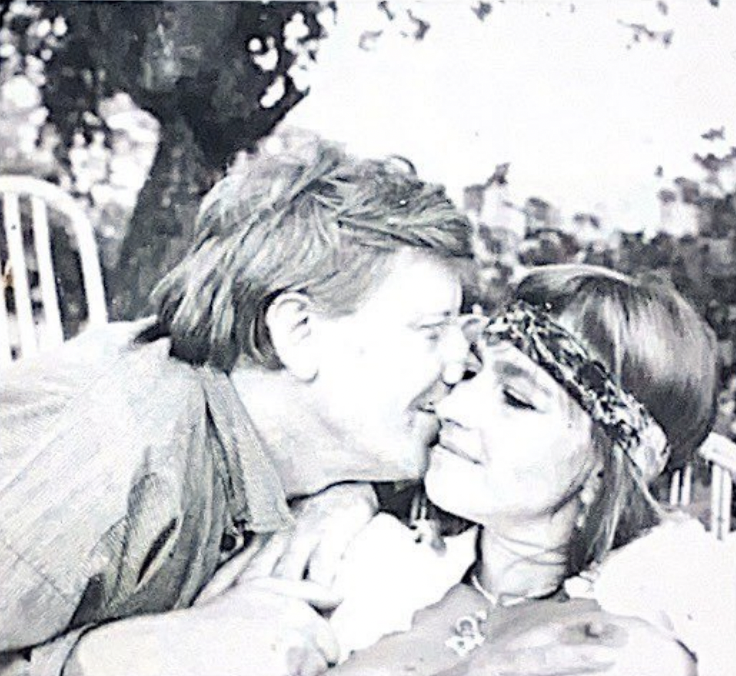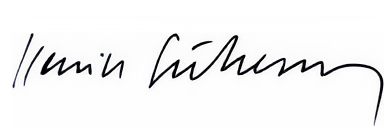Words by Esme Blair
„Paul’s sculptures are here, they look so beautiful all around the garden.“ I called German photographer Karin Szekessey on an early afternoon, just as summer was unfurling its eyclashes in France. She was in Avignon and I in Paris, and we agreed it was athame I couldn’t be there in person. Her portrait photos have always had such an ease of expression that make us almost oblivious to her presence, it would have been nice to be there to portrait the portraitist.
Szekessey revealed to me that a lot of her photography formerly put food on the family table as a means of necessity; it was very much a money-making enterprise for her once upon a time. Szekessey’s photographs also stretch further than portraits- her work reaches equally into art photography; more often than not consisting of naked women skipping or reposing but always playing in strange sparse interiors.
The nude female form is an emblem that she shared with her husband – she quipped „he did everything to get closer to the female figure.“
Paul Wunderlich was born in a small town just outside Berlin, and Szekessey in the West of Germany in the city of Essen. The two met through Wunderlich’s then girlfriend in 1961. Szekessey took his portrait and a couple of years later they were seeing each other. She tells me that she was married at the time thus theirs was a secret romance for a
while. But by 1971 she was pregnant and they were married. When they had first met, cash was sparse – either at cause of or despite of their both being an industry oddity. Szekessey was one of the few female photographers of the late fifties/early sixties. Navigating the already trivial world of photography was a challenge; „only stupid people would do photography back then,“ she told me. As a woman she was doubly hindered, but more than managed – she was working for magazines and funding the lives of her and her children proficiently. She mused that photography took an about-turn when it was suddenly perceived as incredibly desirable a profession thanks to Michelangelo Antonioni’s 1966 film Blow-Up, having previously been seen as much more on the margins. For Wunderlich, he was working as Germany’s youngest art professor in 1963 at the age of 36 – thus also a little at odds with his professional life, In 1968 he decided to give his own practice a chance and gave up teaching to become a fully-fledged artist.
The two were collaborating in the early days of their relationship but remained to divulge very similar subjects throughout their own work and lives together even after this stint However when I asked whether there was an open collaboration or correspondence between their practices throughout their lives, Szekessey told me no. In fact apart from their early collaboration period they kept their work very separate- any motifs that permeated from one to another happened more like a means of
osmosis; there was something in the air. Dark and yet lighthearted- the subject matter of the nude and the eerie is part and parcel of both of their practices. Wunderlich’s surfaces are busy and dirtied yet treated and smooth. The women are flat but modeled with generous shadow.
Szekessey’s lens is blurry and oneiric but situated in the real. Both of their images are often covered by a sheath of mist enveloping us in a hazy vision akin to an evening fog. Dusky dawny night times of day- the time for dreaming.

Karin Szekessy and Paul Wunderlich, 1971
The pair published a book in 1980 of the work they had made together titled „Korrespondenzen“ in German in 1977, later translated to „Transpositions“ in English in 1980. It did very well in Japan and the two had exhibitions, collectors and critical success around the country for a while before the great Hanshin earthquake in 1995 slowed things down as the country had to spend almost 10 trillion on repairs, In fact they had experience ed a prior interest after 1968 when Wunderlich surge of It was earlıer had his first major solo show in their relationship, and Szekessy said to me that occasionally he would ask for one of her photos to paint from. It felt good to have her work excite something in someone else, husband or otherwise.
His painting Daniela mit dem Danschuh corresponds to Szekessey’s Daniela Stuhl Hell. They each hold their own- hers in the stark paper scene in which the young nude woman looks both bashful but at ease, his in bis airbrushed finish and disfigured forms that Nit around the picture plane, carried by the same interior breeze that lifts up the girl’s locks of hair.
Painting from photos was really rather frowned upon at the time- it wasn’t until they started showing their work that they started to get a lot of respect from their peers on the matter. She later tells me that Gerhard Richter (a friend of the couple) was once given a photograph by Szekessey of Wunderlich shooting a rabbit. The picture was small and thing-like. Richter took influence from this photo as well as Wunderlich’s technique of painting after photography.
Objecthood and image flit between a marry and a tension- seeing that photography itself can be like painting.
Paul’s women were often depicted stronger than his men.
She tells me she often would get phone calls from friends in the process of moving out and ask to take photos for a session in the recently emptied interiors- filled with the dust of the freshly relocated. It’s this that gives the photos their other-worldly quality. Both the environment and the women are stripped bare- occasionally embellished with a pair of pale leather gloves or a couple of house plants.
She also regularly used long exposure, thus doubly putting us at odds with the gauzy image we are faced with. She recalled to me the time she met and shot Hans Bellmer. He was living in a very dark room on Rue Mouffetard in the fifth arrondissement in Paris- the kitchen and the bed shared the same space. She was around 23 years old and loved the work he was doing with dolls and the female body, so they met and she took his portrait.
Years later she said she visited him when he was further into his career in a much more affluent position, Iiving in Rue Saint Honore (for those of us who are lucky enough to know Paris, the grandeur of this flat can be imagined by the mention of that road alone), but, she said, a melancholy to him and his wife remained. The cloud over their heads had not parted, despite the success, recognition and wealth they had since gained.
It feels apt that Szekessey photographed Hans Bellmer- not due to her being shrouded in melancholy, but for the similar air of contorted bodily depiction in her work. A woman in her photo wraps herself in a scarf so as to appear armless, another moves about the room so that the exposure renders her barely there, instead becoming a transparent phantom. German artists were exploring transfigurations of the flesh after the second world war- artists like George Baselitz or Max Ernst would express fears and tensions also through the destruction or reconfiguration of the human form.
Both Bellmer and Szekessey investigated a kind of distortion and dismembering. Bellmer created dolls that were all torso no limbs or face, or did drawings ol genitals that also had eyes and a mouth. Szekessey’s blurred faces and mask-wearing women seem to similarly nod to this German post-war trauma. She tells me that she too would play with dolls It was a luxury she wasn’t aflorded as a younger girl because of rations after the war.
Thus at receiving one at twelve years old she indulged in the play- decapitating her and reconfiguring her tiny dolly body into a surrealist picture.
Her photos aren’t too dissimilar in their curiosity and rearrangement of grown adult women. Other than Hans Bellmer, she has also photographed idols like Joseph Beuys and James Baldwin; the big leagues. Unintimidated, Szekessey would do her rescarch, search for a common ground in a prior conversation with whoever she is shooting, then take a couple of photos in a way that the sitters barely notice it’s happening before it’s already over. The photos are casual. We are swept up in a ludic relationship with art and intellectual legends- we feel as though we are playfully interacting with Baldwin as he sits high up on a stained wall on a cloudy day, smiling in the swing of conversation.
Before his passing in 2010 Wunderlich dove almost exclusively into 3D work. His sculptures were of an aerodynamic kind- fluidly formed out of casted liquid bronze before solidifying into enchanting supernatural sculptures He completed a chess board and even a range of crockery- the Rosenthal Mythos cups and saucers are to be lifted by their wings- as if they would fly if airborne rather than smashing into smithereens as expected. A lot of the sculptures now adorn the garden of Szekessey’s home in Provence, between which she splits her time with Hamburg.
Szekessey tells me she is now very involved with digital photography; She has been since 2000 in fact. She has her own printing set up and enjoys the case of making photos digitally in comparison to the process and toxic chemicals of darkroom printing she had been doing for years in her carlier career. She told me she’s not been to Germany for over a year now- the Pandemic has separated her from her family. They’re expected two weeks from our conversation so I bode her a good visit and a farewell. I pictured them in the garden pouring out cold drinks in the sweltering Avignon sun amongst Wunderlich’s bronze sculptures.

